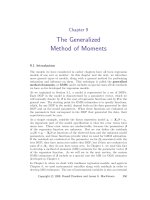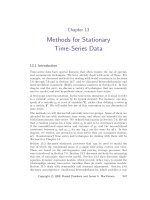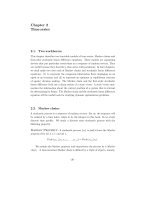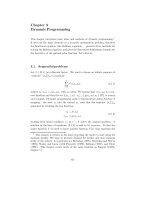Recursive macroeconomic theory, Thomas Sargent 2nd Ed - Chapter 1 potx
Bạn đang xem bản rút gọn của tài liệu. Xem và tải ngay bản đầy đủ của tài liệu tại đây (213.99 KB, 25 trang )
Part I
The imperialism of recursive meth-
ods
Chapter 1
Overview
1.1. Warning
This chapter provides a non-technical summary of some themes of this book.
We debated whether to put this chapter first or last. A way to use this chapter
is to read it twice, once before reading anything else in the book, then again
after having mastered the techniques presented in the rest of the book. That
second time, this chapter will be easy and enjoyable reading, and it will remind
you of connections that transcend a variety of apparently disparate topics. But
on first reading, this chapter will be difficult partly because the discussion is
mainly literary and therefore incomplete. Measure what you have learned by
comparing your understandings after those first and second readings. Or just
skip this chapter and read it after the others.
1.2. A common ancestor
Clues in our mitochondrial DNA tell biologists that we humans share a com-
mon ancestor called Eve who lived 200,000 years ago. All of macroeconomics
too seems to have descended from a common source, Irving Fisher’s and Mil-
ton Friedman’s consumption Euler equation, the cornerstone of the permanent
income theory of consumption. Modern macroeconomics records the fruit and
frustration of a long love-hate affair with the permanent income mechanism. As
a way of summarizing some important themes in our book, we briefly chronicle
some of the high and low points of this long affair.
– 1–
2 Overview
1.3. The savings problem
A consumer wants to maximize
E
0
∞
t=0
β
t
u (c
t
)(1.3.1)
where β ∈ (0, 1), u is a twice continuously differentiable, increasing, strictly con-
cave utility function, and E
0
denotes a mathematical expectation conditioned
on time 0 information. The consumer faces a sequence of budget constraints
1
A
t+1
= R
t+1
(A
t
+ y
t
− c
t
)(1.3.2)
for t ≥ 0, where A
t+1
≥ A is the consumer’s holdings of an asset at the
beginning of period t +1, A
is a lower bound on asset holdings, y
t
is a random
endowment sequence, c
t
is consumption of a single good, and R
t+1
is the gross
rate of return on the asset between t and t + 1. In the general version of the
problem, both R
t+1
and y
t
can be random, though special cases of the problem
restrict R
t+1
further. A first-order necessary condition for this problem is
βE
t
R
t+1
u
(c
t+1
)
u
(c
t
)
≤ 1, =ifA
t+1
>A. (1.3.3)
This Euler inequality recurs as either the cornerstone or the strawman in many
theories contained in this book.
Different modelling choices put (1.3.3) to work in different ways. One can
restrict u, β , the return process R
t+1
, the lower bound on assets A,theincome
process y
t
, and or the consumption process c
t
in various ways. By making
alternative choices about restrictions to impose on subsets of these objects,
macroeconomists have constructed theories about consumption, asset prices,
and the distribution of wealth. Alternative versions of equation (1.3.3) also
underlie Chamley’s (1986) and Judd’s (1985b) striking results about eventually
not taxing capital.
1
We use a different notation in chapter 16: A
t
here conforms to −b
t
in
chapter 16.
The savings problem 3
1.3.1. Linear-quadratic permanent income theory
To obtain a version of the permanent income theory of Friedman (1955) and Hall
(1978), set R
t+1
= R ,imposeR = β
−1
, and assume that u is quadratic so that
u
is linear. Allow {y
t
} to be an arbitrary stationary process and dispense with
the lower bound A
. The Euler inequality (1.3.3) then implies that consumption
is a martingale:
E
t
c
t+1
= c
t
. (1.3.4)
Subject to a boundary condition that
2
E
0
∞
t=0
β
t
A
2
t
< ∞,equations(1.3.4)
and the budget constraints (1.3.2)canbesolvedtoyield
c
t
=
r
1+r
E
t
∞
j=0
1
1+r
j
y
t+j
+ A
t
(1.3.5)
where 1 + r = R.Equation(1.3.5) expresses consumption as a fixed marginal
propensity to consume
r
1+r
that is applied to the sum of human wealth – namely
E
t
∞
j=0
1
1+r
j
y
t+j
– and financial wealth. This equation has the following
notable features: (1) consumption is smoothed on average across time – current
consumption depends only on the expected present value of non-financial in-
come; (2) feature (1) opens the way to Ricardian equivalence: redistributions of
lump sum taxes over time that leave the expected present value of non-financial
income unaltered do not affect consumption; (3) there is certainty equivalence:
increases in the conditional variances of future incomes about their forecast val-
ues do not affect consumption (though they do diminish the consumer’s utility);
(4) a by-product of certainty equivalence is that the marginal propensities to
consume out of financial and non-financial wealth are equal.
This theory continues to be a workhorse in much good applied work (see
Ligon (1998) and Blundell and Preston (1999) for recent creative applications).
Chapter 5 describes conditions under which certainty equivalence prevails while
chapters5and2alsodescribethestructure of the cross-equation restrictions ra-
tional expectations that expectations imposes and that empirical studies heavily
exploit.
2
The motivation for using this boundary condition instead of a lower bound
A
on asset holdings is that there is no ‘natural’ lower bound on assets holdings
when consumption is permitted to be negative, as it is when u is quadratic in
c. Chapters 17 and 8 discuss what are called ‘natural borrowing limits’, the
lowest possible appropriate values of A
in the case that c is nonnegative.
4 Overview
1.3.2. Precautionary savings
A literature on ‘the savings problem’ or ‘precautionary saving’ investigates the
consequences of altering the assumption in the linear-quadratic permanent in-
come theory that u is quadratic, an assumption that makes the marginal utility
of consumption become negative for large enough c. Rather than assuming that
u is quadratic, the literature on the savings problem assumes that u increasing
and strictly concave. This assumption keeps the marginal utility of consumption
above zero. We retain other features of the linear-quadratic model (βR =1,
{y
t
} is a stationary process), but now impose a borrowing limit A
t
≥ a.
With these assumptions, something amazing occurs: Euler inequality (1.3.3)
implies that the marginal utility of consumption is a nonnegative supermartin-
gale.
3
That gives the model the striking implication that c
t
→
as
+∞ and
A
t
→
as
+∞,where→
as
means almost sure convergence. Consumption and
wealth will fluctuate randomly in response to income fluctuations, but so long
as randomness in income continues, they will drift upward over time without
bound. If randomness eventually expires in the tail of the income process, then
both consumption and income converge. But even a small amount of perpetual
random fluctuations in income is enough to cause consumption and assets to
diverge to +∞. This response of the optimal consumption plan to randomness
is required by the Euler equation (1.3.3) and is called precautionary savings.
By keeping the marginal utility of consumption positive, precautionary savings
models arrest the certainty equivalence that prevails in the linear-quadratic per-
manent income model. Chapter 16 studies the savings problem in depth and
struggles to understand the workings of the powerful martingale convergence
theorem. The supermartingale convergence theorem also plays an important
role in the model insurance with private information in chapter 19.
3
See chapter 16. The situation is simplest in the case that the y
t
process is
i.i.d. so that the value function can be expressed as a function of level y
t
+ A
t
alone: V (A + y). Applying the Beneveniste-Scheinkman formula from chapter
3showsthatV
(A + y)=u
(c), which implies that when βR =1,(1.3.3)
becomes E
t
V
(A
t+1
+ y
t+1
) ≤ V
(A
t
+ y
t
), which states that the derivative of
the value function is a nonnegative supermartingale. That in turn implies that
A almost surely diverges to +∞.
The savings problem 5
1.3.3. Complete markets, insurance, and the distribution of wealth
To build a model of the distribution of wealth, we consider a setting with many
consumers. To start, imagine a large number of ex ante identical consumers
with preferences (1.3.1) who are allowed to share their income risk by trading
one-period contingent claims. For simplicity, assume that the saving possibility
represented by the budget constraint (1.3.2) is no longer available
4
but that
it is replaced by access to an extensive set of insurance markets. Assume that
household i has an income process y
i
t
= g
i
(s
t
)wheres
t
is a state-vector gov-
erned by a Markov process with transition density π(s
|s), where s and s
are
elements of a common state space S. (See chapters 2 and 8 for material about
Markov chains and their uses in equilibrium models.) Each period every house-
hold can trade one-period state contingent claims to consumption next period.
Let Q(s
|s) be the price of one unit of consumption next period in state s
when
the state this period is s. When household i has the opportunity to trade such
state-contingent securities, its first-order conditions for maximizing (1.3.1) are
Q (s
t+1
|s
t
)=β
u
c
i
t+1
(s
t+1
)
u
c
i
t
(s
t
)
π (s
t+1
|s
t
)(1.3.6)
Notice that
s
t+1
Q(s
t+1
|s
t
)ds
t+1
is the price of a risk-free claim on consumption
one period ahead: it is thus the reciprocal of the gross risk-free interest rate from
R. Therefore, if we sum both sides of (1.3.6) over s
t+1
, we obtain our standard
consumption Euler condition (1.3.3) at equality.
5
Thus, the complete markets
equation (1.3.6) is consistent with our complete markets Euler equation (1.3.3),
but (1.3.6) imposes more. We will exploit this fact extensively in chapter 15.
In a widely studied special case, there is no aggregate risk so that
i
y
i
t
=
i
g
i
(s
t
)di = constant. In that case, it can be shown that the competitive
equilibrium state contingent prices become
Q (s
t+1
|s
t
)=βπ (s
t+1
|s
t
) . (1.3.7)
This in turn implies that the risk-free gross rate of return R is β
−1
. If we substi-
tute (1.3.7) into (1.3.6), we discover that c
i
t+1
(s
t+1
)=c
i
t
(s
t
) for all (s
t+1
,s
t
).
4
It can be shown that even if it were available, people would not want to use
it.
5
That the asset is risk-free becomes manifested in R
t+1
being a function of
s
t
,sothatitisknownatt.
6 Overview
Thus, the consumption of consumer i is constant across time and across states
of nature s, so that in equilibrium all idiosyncratic risk is insured away. Higher
present-value-of-endowment consumers will have permanently higher consump-
tion than lower present-value-of-endowment consumers, so that there is a non-
degenerate cross-section distribution of wealth and consumption. In this model,
the cross-section distributions of wealth and consumption replicate themselves
over time, and furthermore each individual forever occupies the same position
in that distribution.
A model that has the cross section distribution of wealth and consumption
being time invariant is not a bad approximation to the data. But there is ample
evidence that individual households’ positions within the distribution of wealth
move over time.
6
Several models described in this book alter consumers’ trading
opportunities in ways designed to frustrate risk sharing enough to cause individ-
uals’ position in the distribution of wealth to change with luck and enterprise.
One class that emphasizes luck is the set of incomplete markets models started
by Truman Bewley. It eliminates the household’s access to almost all markets
and returns it to the environment of the precautionary saving model.
1.3.4. Bewley models
At first glance, the precautionary saving model with βR = 1 seems like a bad
starting point for building a theory that aspires to explain a situation in which
cross section distributions of consumption and wealth are constant over time
even as individual experience random fluctuations within that distribution. A
panel of households described by the precautionary savings model with βR =1
would have cross section distributions of wealth and consumption that march
upwards and never settle down. What have come to be called Bewley models
are constructed by lowering the interest rate R to allow those cross section dis-
tributions to settle down. Bewley models are arranged so that the cross section
distributions of consumption, wealth, and income are constant over time and so
that the asymptotic stationary distributions consumption, wealth, and income
for an individual consumer across time equal the corresponding cross section
6
See Diaz-Gim´enez,Quadrini, and Rıios-Rull (1997), Krueger and Perri (2003a,
2003b), Rodriguez, D´ıiaz-Gim´enez, Quadrini, nd R´ıos-Rull (2002) and Davies
and Shorrocks (2000).
The savings problem 7
R
E
Ŧ1
E[y]
E[a(R)]
E[a(R)]
Figure 1.3.1: Mean of time series average of household con-
sumption as function of risk-free gross interest rate R.
distributions across people. A Bewley model can thus be thought of as starting
with a continuum of consumers operating according to the precautionary saving
model with βR = 1 and its diverging individual asset process. We then lower
the interest rate enough to make assets converge to a distribution whose cross
section average clears a market for a risk-free asset. Different versions of Bewley
models are distinguished by what the risk free asset is. In some versions it is a
consumption loan from one consumer to another; in others it is fiat money; in
others it can be either consumption loans or fiat money; and in yet others it is
claims on physical capital. Chapter 17 studies these alternative interpretations
of the risk-free asset.
As a function of a constant gross interest rate R , Figure 1.3.1 plots the
time-series average of asset holdings for an individual consumer. At R = β
−1
,
the time series mean of the individual’s assets diverges, so that Ea(R) is infinite.
For R<β
−1
, the mean exists. We require that a continuum of ex ante identical
but ex post different consumers share the same time series average Ea(R)and
also that the distribution of a over time for a given agent equals the distribution
of A
t+1
at a point in time across agents. If the asset in question is a pure
consumption loan, we require as an equilibrium condition that Ea(R)=0,so
8 Overview
that borrowing equals lending. If the asset is fiat money, then we require that
Ea(R)=
M
p
,whereM is a fixed stock of fiat money and p is the price level.
Thus, a Bewley model lowers the interest rate R enough to offset the pre-
cautionary savings force that with βR = 1 propels assets upward in the savings
problem. Precautionary saving remains an important force in Bewley models:
an increase in the volatility of income generally pushes the Ea(R) curve to the
right, driving the equilibrium R downward.
1.3.5. History dependence in standard consumption models
Individuals’ positions in the wealth distribution are frozen in the complete mar-
kets model, but not in the Bewley model, reflecting the absence or presence, re-
spectively, of history dependence in equilibrium allocation rules for consumption.
The preceding version of the complete markets model erases history dependence
while the savings problem model and the Bewley model do not.
History dependence is present in these models in an easy to handle recur-
sive way because the household’s asset level completely encodes the history of
endowment realizations that it has experienced. We want a way of represent-
ing history dependence more generally in contexts where a stock of assets does
not suffice to summarize history. History dependence can be troublesome be-
cause without a convenient low-dimensional state variable to encode history, it
require that there be a separate decision rules for each date that expresses the
time t decision as a function of the history at time t, an object with a number
of arguments that grows exponentially with t. As analysts, we have a strong
incentive to find a low dimensional state variable. Fortunately, economists have
made tremendous strives in handling history dependence with recursive meth-
ods that summarize a history with a single number and that permit compact
time-invariant expressions for decision rules. We shall discuss history depen-
dence later in this chapter and will encounter many such examples in chapters
18, 22, 19, and 20.
The savings problem 9
1.3.6. Growth theory
Equation (1.3.3) is also a key ingredient of optimal growth theory (see chapters
11 and 14). In the one-sector optimal growth model, a representative household
solves a version of the savings problem in which the single asset is interpreted
as a claim on the return from a physical capital stock K that enters a constant
returns to scale production function F (K, L), where L is labor input. When
returns to capital are tax free, the theory equates the gross rate of return R
t+1
to
the gross marginal product of capital net of deprecation, namely, F
k,t+1
+(1−δ),
where F
k
(k, t + 1) is the marginal product of capital and δ is a depreciation
rate. Suppose that we add leisure to the utility function, so that we replace
u(c) with the more general one-period utility function U(c, ), where is the
household’s leisure. Then the appropriate version of the consumption Euler
condition (1.3.3) at equality becomes
U
c
(t)=βU
c
(t +1)[F
k
(t +1)+(1− δ)] (1.3.8)
The constant returns to scale property implies that F
k
(K, N)=f
(k)where
k = K/N and F (K, N)=Nf(K/N). If there exists a steady state in which k
and c are constant over time, then equation (1.3.8) implies that it must satisfy
ρ + δ = f
(k)(1.3.9)
where β
−1
≡ (1+ρ). The value of k that solves this equation is called the ‘aug-
mented Golden rule’ steady state level of the capital-labor ratio. This celebrated
equation shows how technology (in the form of f and δ ) and time preference
(in the form of β ) are the determinants of the steady state rate level of capital
when income from capital is not taxed. However, if income from capital is taxed
at the flat rate marginal rate τ
k,t+1
, then the Euler equation (1.3.8) becomes
modified
U
c
(t)=βU
c
(t +1)[F
k
(t +1)(1− τ
k,t+1
)+(1− δ)] . (1.3.10)
If the flat rate tax on capital is constant and if a steady state k exists, it must
satisfy
ρ + δ =(1− τ
k
) f
(k) . (1.3.11)
This equation shows how taxing capital diminishes the steady state capital labor
ratio. See chapter 11 for an extensive analysis of the one-sector growth model
10 Overview
when the government levies time-varying flat rate taxes on consumption, capital,
and labor as well as offering an investment tax credit.
1.3.7. Limiting results from dynamic optimal taxation
Equations (1.3.9) and (1.3.11) are central to the dynamic theory of optimal
taxes. Chamley (1986) and Judd (1985b) forced the government to finance
an exogenous stream of government purchases, gave it the capacity to levy
time-varying flat rate taxes on labor and capital at different rates, formulated
an optimal taxation problem (a so-called Ramsey problem), and studied the
possible limiting behavior of the optimal taxes. Two Euler equations play a
decisive role in determining the limiting tax rate on capital in a nonstochastic
economy: the household’s Euler equation (1.3.10), and a similar consumption
Euler-equation for the Ramsey planner that takes the form
W
c
(t)=βW
c
(t +1)[F
k
(t +1)+(1− δ)] (1.3.12)
where
W (c
t
,
t
)=U (c
t
,
t
)+Φ[U
c
(t) c
t
− U
(t)(1−
t
)] (1.3.13)
and where Φ is a Lagrange multiplier on the government’s intertemporal budget
constraint. As Jones, Manuelli, and Rossi (1997) emphasize, if the function
W (c, ) is simply viewed as a peculiar utility function, then what is called the
primal version of the Ramsey problem can be viewed as an ordinary optimal
growth problem with period utility function W instead of U .
7
In a Ramsey allocation, taxes must be such that both (1.3.8) and (1.3.12)
always hold, among other equations. Judd and Chamley note the following
implication of the two Euler equations (1.3.8) and (1.3.12). If the government
expenditure sequence converges and if a steady state exists in which c
t
,
t
,k
t
,τ
kt
all converge, then it must be true that (1.3.9) holds in addition to (1.3.11).
But both of these conditions can prevail only if τ
k
= 0. Thus, the steady state
7
Notice that so long as Φ > 0 (which occurs whenever taxes are necessary),
the objective in the primal version of the Ramsey problem disagrees with the
preferences of the household over (c, ) allocations. This conflict is the source
of a time-inconsistency problem in the Ramsey problem with capital.
The savings problem 11
properties of two versions of our consumption Euler equation (1.3.3) underlie
Chamley and Judd’s remarkable result that asymptotically it is optimal not to
tax capital.
In stochastic versions of dynamic optimal taxation problems, we shall glean
additional insights from (1.3.3) as embedded in the asset pricing equations
(1.3.16) and (1.3.18). In optimal taxation problems, the government has the
ability to manipulate asset prices through its influence on the equilibrium con-
sumption allocation that contributes to the stochastic discount factor m
t+1,t
.
The Ramsey government seeks a way wisely to use its power to revalue its ex-
isting debt by altering state-history prices. To appreciate what the Ramsey
government is doing, it helps to know the theory of asset pricing.
1.3.8. Asset pricing
The dynamic asset pricing theory of Breeden (1979) and Lucas (1978) also starts
with (1.3.3), but alters what is fixed and what is free. The Breedon-Lucas theory
is silent about the endowment process {y
t
} and sweeps it into the background. It
fixes a function u and a discount factor β , and takes a consumption process {c
t
}
as given. In particular, assume that c
t
= g(X
t
)whereX
t
is a Markov process
with transition c.d.f. F (X
|X). Given these inputs, the theory is assigned the
task of restricting the rate of return on an asset, defined by Lucas as a claim on
the consumption endowment:
R
t+1
=
p
t+1
+ c
t+1
p
t
where p
t
is the price of the asset. The Euler inequality (1.3.3) becomes
E
t
β
u
(c
t+1
)
u
(c
t
)
p
t+1
+ c
t+1
p
t
=1. (1.3.14)
This equation can be solved for a pricing function p
t
= p(X
t
). In particular, if
we substitute p(X
t
)into(1.3.14), we get Lucas’s functional equation for p(X).
12 Overview
1.3.9. Multiple assets
If the consumer has access to several assets, a version of (1.3.3) holds for each
asset:
E
t
β
u
(c
t+1
)
u
(c
t
)
R
j,t+1
=1 (1.3.15)
where R
j,t+1
is the gross rate of return on asset j . Given a utility function u,a
discount factor β , and the hypothesis of rational expectations (which allows the
researcher to use empirical projections as counterparts of the theoretical projec-
tions E
t
), equations (1.3.15) put extensive restrictions across the moments of
a vector time series for [c
t
,R
1,t+1
, ,R
J,t+1
]. A key finding of the literature
(e.g., Hansen and Singleton (1983)) is that for u ’s with plausible curvature,
8
consumption is too smooth for {c
t
,R
j,t+1
} to satisfy equation (1.3.15), where
c
t
is measured as aggregate consumption.
Lars Hansen and others have elegantly organized this evidence as follows.
Define the stochastic discount factor
m
t+1,t
= β
u
(c
t+1
)
u
(c
t
)
(1.3.16)
and write (1.3.15) as
E
t
m
t+1,t
R
j,t+1
=1. (1.3.17)
Represent the gross rate of return as
R
j,t+1
=
o
t+1
q
t
where o
t+1
is a one-period ‘pay out’ on the asset and q
t
is the price of the asset
at time t.Then(1.3.17) can be expressed as
q
t
= E
t
m
t+1
o
t+1
. (1.3.18)
The structure of (1.3.18) justifies calling m
t+1,t
a stochastic discount factor: to
determine the price of an asset, multiply the random payoff for each state by
the discount factor for that state, then add over states by taking a conditional
8
Chapter 13 describes Pratt’s (1964) mental experiment for deducing plau-
sible curvature.
The savings problem 13
expectation. Applying the definition of a conditional covariance and a Cauchy-
Schwartz inequality to this equation implies
q
t
E
t
m
t+1
≥ E
t
o
t+1
−
σ
t
(m
t+1,t
)
E
t
m
t+1,t
σ
t
(o
t+1
)(1.3.19)
where σ
t
(y
t+1
) denotes the conditional standard deviation of y
t+1
. Setting
o
t+1
=1in(1.3.18) shows that E
t
m
t+1,t
must be the time t price of a risk-
free one-period security. Inequality (1.3.19) bounds the ratio of the price of
a risky security q
t
to the price of a risk-free security E
t
m
t+1,1
by the right
side, which equals the expected payout on that risky asset minus its conditional
standard deviation σ
t
(o
t+1
) times a ‘market price of risk’ σ
t
(m
t+1,t
)/E
t
m
t+1,t
.
Byusingdataonlyonpayoutso
t+1
and prices q
t
, inequality (1.3.19) has been
used to estimate the market price of risk without restricting how m
t+1,t
relates
to consumption. If we take these atheoretical estimates of σ
t
(m
t+1,t
)/E
t
m
t+1,t
and compare them with the theoretical values of σ
t
(m
t+1,t
)/E
t
m
t+1,t
that we
get with a plausible curvature for u and by imposing ˆm
t+1,t
= β
u
(c
t+1
)
u
(c
t
)
for
aggregate consumption, we find that the theoretical ˆm has far too little volatility
to account for the atheoretical estimates of the conditional coefficient of variation
of m
t+1,t
. As we discuss extensively in chapter 13, this outcome reflects the fact
that aggregate consumption is too smooth to account for atheoretical estimates
of the market price of risk.
There have been two broad types of response to the empirical challenge.
The first retains (1.3.17) but abandons (1.3.16) and instead adopts a statistical
model for m
t+1,t
. Even without the link that equation (1.3.16) provides to
consumption, equation (1.3.17) imposes restrictions across asset returns and
m
t+1,t
thatcanbeusedtoidentifythem
t+1,t
process. Equation (1.3.17)
contains no-arbitrage conditions that restrict the joint behavior of returns. This
has been a fruitful approach in the affine term structure literature (see Backus
and Zin (1993), Piazzesi (2000), and Ang and Piazzesi (2003))
9
Another approach has been to disaggregate and to write the household-i
version of (1.3.3):
βE
t
R
t+1
u
(c
i,t+1
)
u
(c
it
)
≤ 1, =ifA
i,t+1
>A
i
. (1.3.20)
9
Affine term structure models generalize earlier models that implemented
rational expectations versions of the expectations theory of the term structure
of interest rates. See Campbell and Shiller (1991), Hansen and Sargent (1991),
and Sargent (1979).
14 Overview
If at time t, a subset of households are on the corner, (1.3.20) will hold with
equality only for another subset of households. This second set of households
price assets.
10
Chapter 20 describes a model of Harald Zhang (1997) and Alvarez and Jer-
mann (2000, 2001). The model introduces participation (collateral) constraints
and shocks in a way that makes a changing subset of agents i satisfy (1.3.20).
Zhang and Alvarez and Jermann formulate these models by adding participa-
tion constraints to the recursive formulation of the consumption problem based
on (1.4.7). Next we briefly describe the structure of these models and their
attitude toward our theme equation, the consumption Euler equation (1.3.3).
The idea of Zhang and Alvarez and Jermann was to meet the empirical asset
pricing challenges by disrupting (1.3.3). As we shall see, that requires eliminat-
ing some of the assets that some of the households can trade. These advanced
models exploit a convenient method for representing and manipulating history
dependence.
1.4. Recursive methods
The pervasiveness of the consumption Euler inequality will be a significant sub-
stantive theme of this book. We now turn to a methodological theme, the
imperialism of the recursive method called dynamic programming.
The notion that underlies dynamic programming is a finite-dimensional
object called the state that, from the point of view of current and future payoffs,
completely summarizes the current situation of a decision maker. If an optimum
problem has a low dimensional state vector, immense simplifications follow. A
recurring theme of modern macroeconomics and of this book is that finding an
appropriate state vector is an art.
To illustrate the idea of the state in a simple setting, return to the saving
problem and assume that the consumer’s endowment process is a time-invariant
function of a state s
t
that follows a Markov process with time-invariant one-
period transition density π(s
|s) and initial density π
0
(s), so that y
t
= y(s
t
). To
begin, recall the description (1.3.5) of consumption that prevails in the special
10
David Runkle (1991) and Gregory Mankiw and Steven Zeldes (1991) checked
(1.3.20) for subsets of agents.
Recursive methods 15
linear-quadratic version of the savings problem. Under our present assumption
that y
t
is a time-invariant function of the Markov state, (1.3.5) and the house-
hold’s budget constraint imply the following representation of the household’s
decision rule:
c
t
= f (A
t
,s
t
)(1.4.1a)
A
t+1
= g (A
t
,s
t
) . (1.4.1b)
Equation (1.4.1a) represents consumption as a time-invariant function of a state
vector (A
t
,s
t
). The Markov component s
t
appears in (1.4.1a) because it con-
tains all of the information that is useful in forecasting future endowments (for
the linear-quadratic model, (1.3.5) reveals the household’s incentive to forecast
future incomes); and the asset level A
t
summarizes the individual’s current
financial wealth. The s component is assumed to be exogenous to the house-
hold’s decisions and has a stochastic motion governed by π(s
|s). But the future
path of A is chosen by the household and is described by (1.4.1b). The system
formed by (1.4.1) and the Markov transition density π(s
|s)issaidtobere-
cursive because it expresses a current decision c
t
as a function of the state and
tells how to update the state. By iterating (1.4.1b), notice that A
t+1
can be
expressed as a function of the history [s
t
,s
t−1
, ,s
0
]andA
0
. The endogenous
state variable financial wealth thus encodes all pay-off relevant aspects of the
history of the exogenous component of the state s
t
.
Define the value function V (A
0
,s
0
) as the optimum value of the saving
problem starting from initial state (A
0
,s
0
). The value function V satisfies the
following functional equation known as a Bellman equation:
V (A, s)=max
c,A
{u (c)+βE [V (A
,s
) |s]} (1.4.2)
where the maximization is subject to A
= R(A+y−c)andy = y(s). Associated
with a solution V (A, s) of the Bellman equation is the pair of policy functions
c = f (A, s)(1.4.3a)
A
= g (A, s)(1.4.3b)
from (1.4.1). The ex ante value (i.e., the value of (1.3.1) before s
0
is drawn)
of the saving problem is then
v (A)=
s
V (A, s) π
0
(s) . (1.4.4)
16 Overview
We shall make ample use of the ex ante value function.
1.4.1. Methodology: dynamic programming issues a challenge
Dynamic programming is now recognized as a powerful method for studying
private agents’ decisions and also the decisions of a government that wants to
design an optimal policy in the face of constraints imposed on it by private
agents’ best responses to that government policy. But it has taken a long time
for the power of dynamic programming to be realized for government policy
design problems.
Dynamic programming had been applied since the late 1950s to design
government decision rules to control an economy whose transition laws included
rules that described the decisions of private agents. In 1976 Robert E. Lucas, Jr.
published his now famous Critique of dynamic-programming-based econometric
policy evaluation procedures. The heart of Lucas’s critique was the implication
for government policy evaluation of a basic property that pertains to any opti-
mal decision rule for private agents with a form (1.4.3) that attains a Bellman
equation like (1.4.2). The property is that the optimal decision rules (f,g)de-
pend on the transition density π(s
|s) for the exogenous component of the state
s. As a consequence, any widely understood government policy that alters the
law of motion for a state variable like s that appears in private agents’ decision
rules should alter those private decision rules. (In the applications that Lucas
had in mind, the s in private agents’ decision problems included variables use-
ful for predicting tax rates, the money supply, and the aggregate price level.)
Therefore, Lucas asserted that econometric policy evaluation procedures that
assumed that private agents’ decision rules are fixed in the face of alterations in
government policy are flawed.
11
Most econometric policy evaluation procedures
at the time were vulnerable to Lucas’s criticism. To construct valid policy eval-
uation procedures, Lucas advocated building new models that would attribute
rational expectations to decision makers.
12
Lucas’s discussant Robert Gordon
11
They were flawed because they assumed ‘no response’ when they should
have assumed ‘best response’ of private agents’ decision rules to government
decision rules.
12
That is, he wanted private decision rules to solve dynamic programming
problems with the correct transition density π for s.
Recursive methods 17
implied that after that ambitious task had been accomplished, we could then
use dynamic programming to compute optimal policies, i.e., to solve Ramsey
problems.
1.4.2. Dynamic programming challenged
But Edward C. Prescott’s 1977 paper Should Control Theory Be Used for Eco-
nomic Stabilization? asserted that Gordon was too optimistic. Prescott claimed
that in his 1977 JPE paper with Kydland he had proved that was it was “logically
impossible” to use dynamic programming to find optimal government policies
in settings where private traders face genuinely dynamic problems. Prescott
said that dynamic programming was inapplicable to government policy design
problems because the structure of the best response of current private decisions
to future government policies prevents the government policy design problem
from being recursive (a manifestation of the time inconsistency of optimal gov-
ernment plans). The optimal government plan would therefore require a gov-
ernment commitment technology and the government policy must take the form
of a sequence of history-dependent decision rules that could not be expressed as
a function of natural state variables.
1.4.3. Imperialistic response of dynamic programming
Much of the subsequent history of macroeconomics belies Prescott’s claim of
‘logical impossibility’. More and more problems that smart people like Prescott
in 1977 thought could not be attacked with dynamic programming can now be
solved with dynamic programming. Prescott didn’t put it this way, but now we
would: in 1977 we lacked a way to handle history-dependence within a dynamic
programming framework. Finding a recursive way to handle history dependence
is a major achievement of the past 25 years and an important methodological
theme of this book that opens the way to a variety of important applications.
We shall encounter important traces of the fascinating history of this topic
in various chapters. Important contributors to the task of overcoming Prescott’s
challenge seemed to work in isolation from one another, being unaware of the
complementary approaches being followed elsewhere. Important contributors
included Shavell and Weiss (1980), Kydland-Prescott (1980), Miller-Salmon
18 Overview
(1982), Pearlman, Currie, Levine (1985), Pearlman (1992), Hansen, Epple,
Roberds (1985). These researchers achieved truly independent discoveries of
the same important idea.
As we discuss in detail in chapter 18, one important approach amounted
to putting a government co-state vector on the co-state equations of the private
decision makers, then proceeding as usual to use optimal control for the govern-
ment’s problem. (A co-state equation is a version of an Euler equation). Solved
forward, the co-state equation depicts the dependence of private decisions on
forecasts of future government policies that Prescott was worried about. The
key idea in this approach was to formulate the government’s problem by tak-
ing the co-state equations of the private sector as additional constraints on the
government’s problem. These amount to ‘promising keeping constraints’ (they
are cast in terms of derivatives of values functions, not value functions them-
selves, because co-state vectors are gradients of value functions). After adding
the costate equations of the private-sector (the ‘followers) to the transition law
of the government (the ‘leader’), one could then solve the government’s problem
by using dynamic programming as usual. One simply writes down a Bellman
equation for the government planner taking the private sector co-state variables
as pseudo-state variables. Then it is almost business as usual (Gordon was cor-
rect!) We say ‘almost’ because after the Bellman equation is solved, there is one
more step: to pick the initial value of the private sector’s co-state. To maximize
the government’s criterion, this initial condition should be set to zero because
initially there are no promises to keep. The government’s optimal decision is
a function of the natural state variable and the co-state variables. The date t
co-state variables encode history and record the ‘cost’ to the government at t of
confirming the private sector’s prior expectations about the government’s time
t decisions, expectations that were embedded in the private sector’s decisions
before t. The solution is time-inconsistent (the government would always like
to re-initialize the time t multiplier to zero and thereby discard past promises
– but that is ruled out by the assumption that the government is committed to
follow the optimal plan). See chapter 18 for many technical details, computer
programs, and an application.
Recursive methods 19
1.4.4. History dependence and ‘dynamic programming squared’
Rather than pursue the ‘co-state on the co-state’ approach further, we now
turn to a closely related approach that we illustrate in a dynamic contract de-
sign problem. While superficially different from the government policy design
problem, the contract problem has many features in common with it. What
is again needed is a recursive way to encode history dependence. Rather than
use co-state variables, we move up a derivative and work with promised val-
ues. This leads to value functions appearing inside value functions or ‘dynamic
programming squared’.
Define the history s
t
of the Markov state by s
t
=[s
t
,s
t−1
, ,s
0
]andlet
π
t
(s
t
) be the density over histories induced by π, π
0
. Define a consumption
allocation rule as a sequence of functions, the time component of which maps s
t
into a choice of time t consumption, c
t
= σ
t
(s
t
), for t ≥ 0. Let c = {σ
t
(s
t
)}
∞
t=0
.
Define the (ex ante) value associated with an allocation rule as
v (c)=
∞
t=0
s
t
β
t
u
σ
t
s
t
π
t
s
t
(1.4.5)
For each possible realization of the period zero state
s
0
,thereisacontinuation
history s
t
|
s
0
. The observation that a continuation history is itself a complete
history is our first hint that a recursive formulation is possible.
13
For each
possible realization of the first period s
0
, a consumption allocation rule implies
aone-periodcontinuation consumption rule c|
s
0
. A continuation consumption
rule is itself a consumption rule that maps histories into time series of consump-
tion. The one-period continuation history treats the time t + 1 component of
the original history evaluated at
s
0
as the time t component of the continuation
history. The period t consumption of the one period continuation consumption
allocation conforms to the time t + 1 component of original consumption allo-
cation evaluated at
s
0
. The time- and state-separability of (1.4.5) then allow
us to represent v(c) recursively as
v (c)=
s
0
[u (c
0
(s
0
)) + βv(c|
s
0
)] π
0
(s
0
) , (1.4.6)
where v(c|
s
0
) is the value of the continuation allocation. We call v(c|
s
0
)the
continuation value. In a special case that successive components of s
t
are i.i.d.
13
See chapters 8 and 22 for discussions of the recursive structure of histories.
20 Overview
and have a discrete distribution, we can write (1.4.6) as
v =
s
[u (c
s
)+βw
s
]Π
s
(1.4.7)
where Π
s
=Prob(y
t
= y
s
)and[y
1
< y
2
···< y
S
] is a grid on which the endow-
ment resides, c
s
is consumption in state s given v,andw
s
is the continuation
value in state s,givenv .Hereweusev in (1.4.7) to denote what was v(c)in
(1.4.6) and w
s
to denote what was v(c|
s
)in(1.4.6).
So far this has all been for an arbitrary consumption plan. Evidently, the
ex ante value v attained by an optimal consumption program must satisfy
v =max
{c
s
,w
s
}
S
s=1
s
[u (c
s
)+βw
s
]Π
s
(1.4.8)
where the maximization is subject to constraints that summarize the individual’s
opportunities to trade current state-contingent consumption c
s
against future
state contingent continuation values w
s
. In these problems, the value of v is an
outcome that depends, in the savings problem for example, on the household’s
initial level of assets. In fact, for the savings problem with i.i.d. endowment
shocks, the outcome is that v is a monotone function of A. This monotonicity
allows the following remarkable representation. After solving for the optimal
plan, use the monotone transformation to let v replace A as a state variable
and represent the optimal decision rule in the form
c
s
= f (v, s)(1.4.9a)
w
s
= g (v,s) . (1.4.9b)
The promised value v (a forward looking variable if there ever was one)
is also the variable that functions as an index of history in (1.4.9). Equation
(1.4.9b) reminds us that v is a ‘backward looking’ variable that registers the
cumulative impact of past states s
t
. The definition of v as a promised value,
for example in (1.4.8), tells us that v is also a forward looking variable that
encodes expectations (promises) about future consumption.
Recursive methods 21
1.4.5. Dynamic principal-agent problems
The right side of (1.4.8) tells the terms on which the household is willing to trade
current utility for continuation utility. Models that confront enforcement and
information problems use the trade-off identified by (1.4.8) to design intertem-
poral consumption plans that optimally balance risk-sharing and intertemporal
consumption smoothing against the need to offer correct incentives. Next we
turn to such models.
We remove the household from the market and hand it over to a plan-
ner or principal who offers the household a contract that the planner designs
to deliver an ex ante promised value v subject to enforcement or information
constraints.
14
Now v becomes a state variable that occurs in the planner’s
value function. We assume that the only way the household can transfer his
endowment over time is to deal with the planner. The saving or borrowing
technology (1.3.1) is no longer available to the agent, though it might be to the
planner. We continue to consider the i.i.d. case mentioned above. Let P (v)be
the ex ante optimal value of the planner’s problem. The presence of a value
function (for the agents) as an argument of the value function of the princi-
pal causes us sometimes to speak of ‘dynamic programming squared.’ dynamic
programming!squaredThe planner ‘earns’ y
t
− c
t
from the agent at time t by
commandeering the agent’s endowment but returning consumption c
t
.The
value function P (v) for a planner who must deliver promised value v satisfies
P (v)= max
{c
s
,w
s
}
S
s=1
[y
s
− c
s
+ βP (w
s
)] Π
s
(1.4.10)
where the maximization is subject to the promise keeping constraint (1.4.7) and
some other constraints that depend on details of the problem, as we indicate
shortly. The other constraints are context-specific manifestations of (1.4.8)
and describe the best response of the agent to the arrangement offered by the
principal. Condition (1.4.7) is a promise-keeping constraint. The planner is
constrained to provide a vector of {c
s
,w
s
}
S
s=1
that delivers the value v .
We briefly describe two types of contract design problems and the con-
straints that confront the planner because of the opportunities that the envi-
ronment grants the agent.
14
Here we are sticking close to two models of Thomas and Worrall (1988,
1990).
22 Overview
To model the problem of enforcement without an information problem, as-
sume that while the planner can observe y
t
each period, the household always
has the option of consuming its endowment y
t
and receiving an ex ante con-
tinuation value v
aut
with which to enter next period, where v
aut
is the ex ante
value the consumer receives by always consuming his endowment. The con-
sumer’s freedom to walk away induces the planner to structure the insurance
contract so that it is never in the household’s interest to defect from the contract
(the contract must be ‘self-enforcing’). A self-enforcing contract requires that
the following participation constraints be satisfied:
u (c
s
)+βw
s
≥ u (y
s
)+βv
aut
∀s. (1.4.11)
A self-enforcing contract provides imperfect insurance when occasionally some of
these participation constraints are binding. When they are binding, the planner
sacrifices consumption smoothing in the interest of providing incentives for the
contract to be self-enforcing.
An alternative specification eliminates the enforcement problem by assum-
ing that once the household enters the contract, it does not have the option to
walk away. A planner wants to supply insurance to the household in the most
efficient way but now the planner cannot observe the household’s endowment.
The planner must trusts the household to report its endowment. It is assumed
that the household will truthfully report its endowment only if it wants to. This
leads the planner to add to the promise keeping constraint (1.4.7) the following
truth telling constraints:
u (c
s
)+βw
s
≥ u (c
τ
)+βw
τ
∀(s, τ) . (1.4.12)
If (1.4.12) holds, the household will always choose to report the true state s.
As we shall see in chapters 19 and 20, the planner elicits truthful reporting by
manipulating how continuation values vary with the reported state. Households
who report a low income today might receive a transfer today, but they suf-
fer an adverse consequence by getting a diminished continuation value starting
tomorrow. The planner structures this menu of choices so that only low endow-
ment households, those who badly want a transfer today, are willing to accept
the diminished continuation value that is the consequence of reporting that low
income today.
At this point, a supermartingale convergence theorem raises its ugly head
again. But this time it propels consumption and continuation utility downward.
Recursive methods 23
The super martingale result leads to what some people have termed the ‘im-
miseration’ property of models in which dynamic contracts are used to deliver
incentives to reveal information.
To enhance our appreciation for the immiseration result,we now touch on
another aspect of macroeconomic’s love-hate affair with the Euler inequality
(1.3.3). In both of the incentive models just described, one with an enforce-
ment problem, the other with an information problem, it is important that the
household not have access to a good risk-free investment technology like that
represented in the constraint (1.3.2) that makes (1.3.3) the appropriate first-
order condition in the saving problem. Indeed, especially in the model with
limited information, the planner makes ample use of his ability to reallocate
consumption intertemporally in ways that can violate (1.3.2) in order to elicit
accurate information from the household. In chapter 19, we shall follow Cole
and Kocherlakota (2001) by allowing the household to save (but not to dissave)
a risk-free asset that bears fixed gross interest rate R = β
−1
. The Euler inequal-
ity comes back into play and alters the character of the insurance arrangement
so that outcomes resemble ones that occur in a Bewley model, provided that
the debt limit in the Bewley model is chosen appropriately.
1.4.6. More applications
We shall study many more applications of dynamic programming and dynamic
programming squared, including models of search in labor markets, reputation
and credible public policy, gradualism in trade policy, unemployment insurance,
monetary economies. It is time to get to work seriously studying the mathe-
matical and economic tools that we need to approach these exciting topics. Let
us begin.
Part II
Tools









